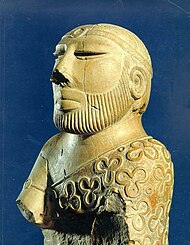Soomra dynasty
Soomra dynasty | |||||||||
|---|---|---|---|---|---|---|---|---|---|
| 1026–1356 (Continued in exile until 1440 in Umerkot) | |||||||||
| Capital | Thari (in present-day Badin District in Sindh) | ||||||||
| Common languages | Sindhi (native language) Arabic (liturgical language) | ||||||||
| Religion | Shia Ismaili | ||||||||
| Government | Monarchy | ||||||||
| History | |||||||||
• Soomra dynasty begins | 1026 | ||||||||
• Soomra dynasty ends | 1356 (Continued in exile until 1440 in Umerkot) | ||||||||
| |||||||||
| History of India |
|---|
 |
| History of Pakistan |
|---|
 |
| Timeline |
|
The Soomra (or Sumra) dynasty was a kingdom of Sindh, and at times adjacent regions, located in what is now present-day Pakistan.[1]
Establishment[]
The Soomras established themselves as a regional power, shortly after Mahmud of Ghazni's invasion (c. AH 416/AD 1025) of Mansura, erstwhile capital of Sindh. The only contemporary source of this campaign is the Diwan-i Farruhi, written by one Abul-Hasan Ali in Persian — he describes the flight (and eventual death by drowning) of Hafif (var. Khafif) but does not specify whether he was the last Habbarid or first Soomra. Later chroniclers like Ali ibn al-Athir (c. late 12th c.) and Ibn Khaldun (c. late 14th c.) attributed the fall of Habbarids to Mahmud of Ghazni, lending credence to the argument of Hafif being the last Habbarid.
Ahmad Hasan Dani as well as Annemarie Schimmel note the early history of Soomras to be sketchy; they have been retrospectively claimed to be Parmar Rajputs but without proof.[2] Some of them were adherents of Isma'ilism — Arab travelers hold them to be "Qarmatians" and correspondence with the Fatimid caliph, Al-Mustansir Billah have been located.[a]
Territory[]
The Ghurids and Ghaznavids continued to rule parts of Sindh, across the eleventh and early twelfth century, alongside Soomrus. The precise delineations are not yet known.
Lineage[]
One of their kings Shimuddin Chamisar had submitted to Iltutmish, the Sultan of Delhi, and was allowed to continue on as a vassal.[3]
Notes[]
- ^ C. 1105, Isma'ilis of Multan had sought refuge in Masura during Ghazni's invasion of the city and reasons for his campaign(s) against Hafif are noted to be the flourishing river trade of Isma'ilis and his (Hafif's) alliance with Jats.
References[]
- ^ "The Arab Conquest". International Journal of Dravidian Linguistics, Volumes 36-37. XXXVI (1): 91. 2007.
The Soomras are believed to be Parmar Rajputs found even today in Rajasthan, Saurashtra, Kutch and Sindh. The Cambridge History of India refers to the Soomras as "a Rajput dynasty the later members of which accepted Islam" (p. 54 ).
- ^ Dani, Ahmad Hasan (2007). History of Pakistan: Pakistan through ages. Sang-e Meel Publications. p. 218. ISBN 978-969-35-2020-0.
But as many kings of the dynasty bore Hindu names, it is almost certain that the Soomras were of local origin. Sometimes they are connected with Paramara Rajputs, but of this there is no definite proof.
- ^ Aniruddha Ray (4 March 2019). The Sultanate of Delhi (1206-1526): Polity, Economy, Society and Culture. Taylor & Francis. pp. 43–. ISBN 978-1-00-000729-9.
- History of Sindh
- Medieval India
- Hindu dynasties
- Dynasties of India
- Dynasties of Pakistan
- Empires and kingdoms of India